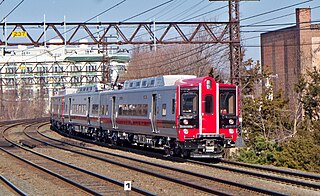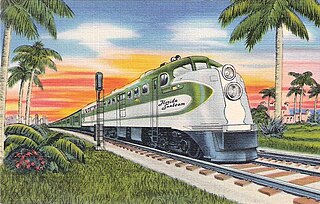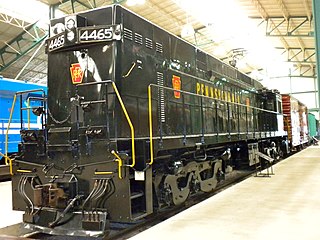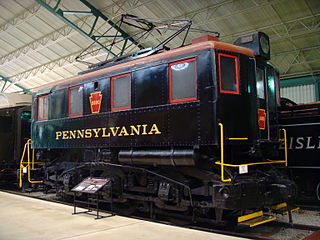
The Penn Central Transportation Company, commonly abbreviated to Penn Central, was an American class I railroad that operated from 1968 to 1976. Penn Central combined three traditional corporate rivals, all united by large-scale service into the New York metropolitan area and New England and Chicago. The new company failed barely two years after formation, the largest bankruptcy in U.S. history at the time. The Penn Central's railroad assets were nationalized into Conrail along with the other bankrupt northeastern roads; its real estate and insurance holdings successfully reorganized into American Premier Underwriters.

Metro-North Railroad, trading as MTA Metro-North Railroad, is a suburban commuter rail service operated by the Metropolitan Transportation Authority (MTA), a public authority of the U.S. state of New York. Metro-North serves the New York Metropolitan Area, running service between New York City and its northern suburbs in New York and Connecticut, including Port Jervis, Spring Valley, Poughkeepsie, Yonkers, New Rochelle, Mount Vernon, White Plains, Southeast and Wassaic in New York and Stamford, New Canaan, Danbury, Bridgeport, Waterbury, and New Haven in Connecticut. Service in Connecticut is operated under contract with the Connecticut Department of Transportation. Metro-North also provides local rail service within the New York City boroughs of Manhattan and the Bronx.

The Northeast Corridor (NEC) is an electrified railroad line in the Northeast megalopolis of the United States. Owned primarily by Amtrak, it runs from Boston in the north to Washington, D.C. in the south, with major stops in Providence, New Haven, Stamford, New York City, Newark, Trenton, Philadelphia, Wilmington, and Baltimore. The NEC closely parallels Interstate 95 for most of its length. Carrying more than 2,200 trains a day, it is the busiest passenger rail line in the United States by ridership and by service frequency.

The New York, New Haven and Hartford Railroad, commonly known as The Consolidated, or simply as the New Haven, was a railroad that operated principally in the New England region of the United States from 1872 to December 31, 1968. Founded by the merger of the New York and New Haven and Hartford and New Haven railroads, the company had near-total dominance of railroad traffic in Southern New England for the first half of the 20th century.
Locomotive classification on the Pennsylvania Railroad took several forms. Early on, steam locomotives were given single-letter classes. As the 26 letters were quickly assigned, that scheme was abandoned for a more complex system. This was used for all of the PRR's steam locomotives, and — with the exception of the final type bought — all electric locomotives also used this scheme.

The Grand Trunk Western Railroad Company was an American subsidiary of the Grand Trunk Railway, later of the Canadian National Railway operating in Michigan, Illinois, Indiana, and Ohio. Since a corporate restructuring in 1971, the railroad has been under CN's subsidiary holding company, the Grand Trunk Corporation. Grand Trunk Western's routes are part of CN's Michigan Division. Its primary mainline between Chicago and Port Huron, Michigan serves as a connection between railroad interchanges in Chicago and rail lines in eastern Canada and the Northeastern United States. The railroad's extensive trackage in Detroit and across southern Michigan has made it an essential link for the automotive industry as a hauler of parts and automobiles from manufacturing plants.

The EMD FL9 is a model of electro-diesel locomotive, capable of operating either as a traditional diesel-electric locomotive or as an electric locomotive powered from a third rail. Sixty units were built between October 1956 and November 1960 by General Motors Electro-Motive Division for the New York, New Haven and Hartford Railroad.

An electro-diesel locomotive is a type of locomotive that can be powered either from an electricity supply or by using the onboard diesel engine. For the most part, these locomotives are built to serve regional, niche markets with a very specific purpose.

The New Haven Line is a 72.7 mi (117.0 km) commuter rail line operated by the Metro-North Railroad in the U.S. states of New York and Connecticut. Running from New Haven, Connecticut, to New York City, the New Haven Line joins the Harlem Line in Mount Vernon, New York, and continues south to Grand Central Terminal in Manhattan. The New Haven Line carries 125,000 passengers every weekday and 39 million passengers a year. The busiest intermediate station is Stamford, with 8.4 million passengers, or 21% of the line's ridership.

The Hudson Line is a commuter rail line owned and operated by the Metro-North Railroad in the U.S. state of New York. It runs north from New York City along the east shore of the Hudson River, terminating at Poughkeepsie. The line was originally the Hudson River Railroad, and eventually became the Hudson Division of the New York Central Railroad. It runs along what was the far southern leg of the Central's famed "Water Level Route" to Chicago.
The Federal Express was an overnight named passenger train run by the Pennsylvania Railroad and the New York, New Haven and Hartford Railroad between Washington, DC's Union Station and Boston, Massachusetts's South Station from 1912 to 1971. At different times, its route has taken it across the Hudson River via a car float between Port Morris and Jersey City, the Poughkeepsie Bridge, and finally the Pennsylvania Tunnel and Terminal Railroad. The final routing was identical to today's high-speed Northeast Corridor.

The ALCO DL-109 was one of six models of A1A-A1A diesel locomotives built to haul passenger trains by the American Locomotive Company (ALCO) between December, 1939 and April, 1945. They were of a cab unit design, and both cab-equipped lead A units DL-103b, DL-105, DL-107, DL-109 and cabless booster B units DL-108, DL-110 models were built. The units were styled by noted industrial designer Otto Kuhler, who incorporated into his characteristic cab the trademark three-piece windshield design. A total of 74 cab units and four cabless booster units were built.

The PRR E44 was an electric, rectifier-equipped locomotive built by General Electric for the Pennsylvania Railroad between 1960 and 1963. The PRR used them for freight service on the Northeast Corridor. They continued in service under Penn Central and Conrail until Conrail abandoned its electric operations in the early 1980s. They were then acquired by Amtrak and NJ Transit, where they lived short lives; all were retired by the mid-1980s. One is preserved at the Railroad Museum of Pennsylvania.

The Pennsylvania Railroad's class B1 comprised 42 electric switcher locomotives built between 1926 and 1935. They were of 0-6-0 wheel arrangement in the Whyte notation with 700 horsepower. As built, the first 28 locomotives in the 1926 order formed semi-permanently coupled pairs grouped in three classes.

The Brookville BL20GH is a diesel-electric locomotive built by the Brookville Equipment Corporation. The locomotive is designed for both freight and passenger service. Brookville built 12 in 2008 for the Metro-North Railroad. The Staten Island Railway operates four nearly identical BL20G locomotives, built by Brookville in December 2008, in work service.

The Virginian EL-C, later known as the New Haven EF-4 and E33, was an electric locomotive built for the Virginian Railway by General Electric in August 1955. They were the first successful production locomotives to use Ignitron rectifier technology. Although they proved to be a successful design, no more EL-Cs were built, due to the small number of railroads that had electrification and the advent of improved electric locomotive technology. They were among the last mainline electric freight locomotives in the United States.

S-Motor was the class designation given by the New York Central to its ALCO-GE built S-1, S-2, S-2a and S-3 electric locomotives. The S-Motors hold the distinction of being the world's first mass-produced main line electric locomotives with the prototype #6000 being constructed in 1904. The S-Motors would serve alone until the more powerful T-motors began to arrive in 1913, eventually displacing them from main line passenger duties. From that point the class was assigned to shorter commuter trains and deadhead rolling stock between Grand Central Terminal and Mott Haven coach yard. Some examples, including the prototype later renumbered #100, would serve in this capacity through the Penn Central merger in 1968, only being retired in the 1970s as long distance passenger traffic to Grand Central dried up.

P-Motor was the class designation given by the New York Central a fleet of 22 ALCO-GE electric passenger locomotives. The P Motors were not only more powerful than previous New York Central electrics, but also a more advanced design using the highly successful 2-C+C-2 wheel arrangement found on the later PRR GG1 and New Haven EP-3 classes as well as nose suspended traction motors. Although originally built and owned by a consortium of railroads involved in the large scale Cleveland Union Terminal project, the New York Central was the majority owner and later acquired them outright in the 1950s when the Terminal's electrification scheme was scrapped in favor of diesel locomotives. Rebuilt and re-classified as P-2, the 21 remaining engines were sent to the New York electrified zone to supplement the aging fleet of T-Motors that had been purchased starting in 1913. There they played out the remainder of their careers pulling the Central's premier passenger trains.

R-Motor was the class designation given by the New York Central one prototype and a later fleet of 42 ALCO-GE built electric freight locomotives for use in the New York Electrified Zone. In conjunction with the P Motors, the Rs marked the second generation of electric locomotives built for the New York Central. Also like the P Motors they used advanced nose suspended traction motors and the R-2s were some of the first North American locomotives to make use of the C-C wheel arrangement, which later became the standard for diesel electric road freight.

The New Haven EP-2 was a class of boxcab electric locomotives built by Baldwin-Westinghouse for the New York, New Haven and Hartford Railroad. The locomotives worked passenger trains on the New Haven's electrified division west of New Haven, Connecticut. Baldwin-Westinghouse delivered 27 locomotives between 1919–1927. The locomotives were an enlarged version of the EP-1 and EF-1 designs. They remained in service until the arrival of the dual-mode EMD FL9 locomotives in 1958.


















